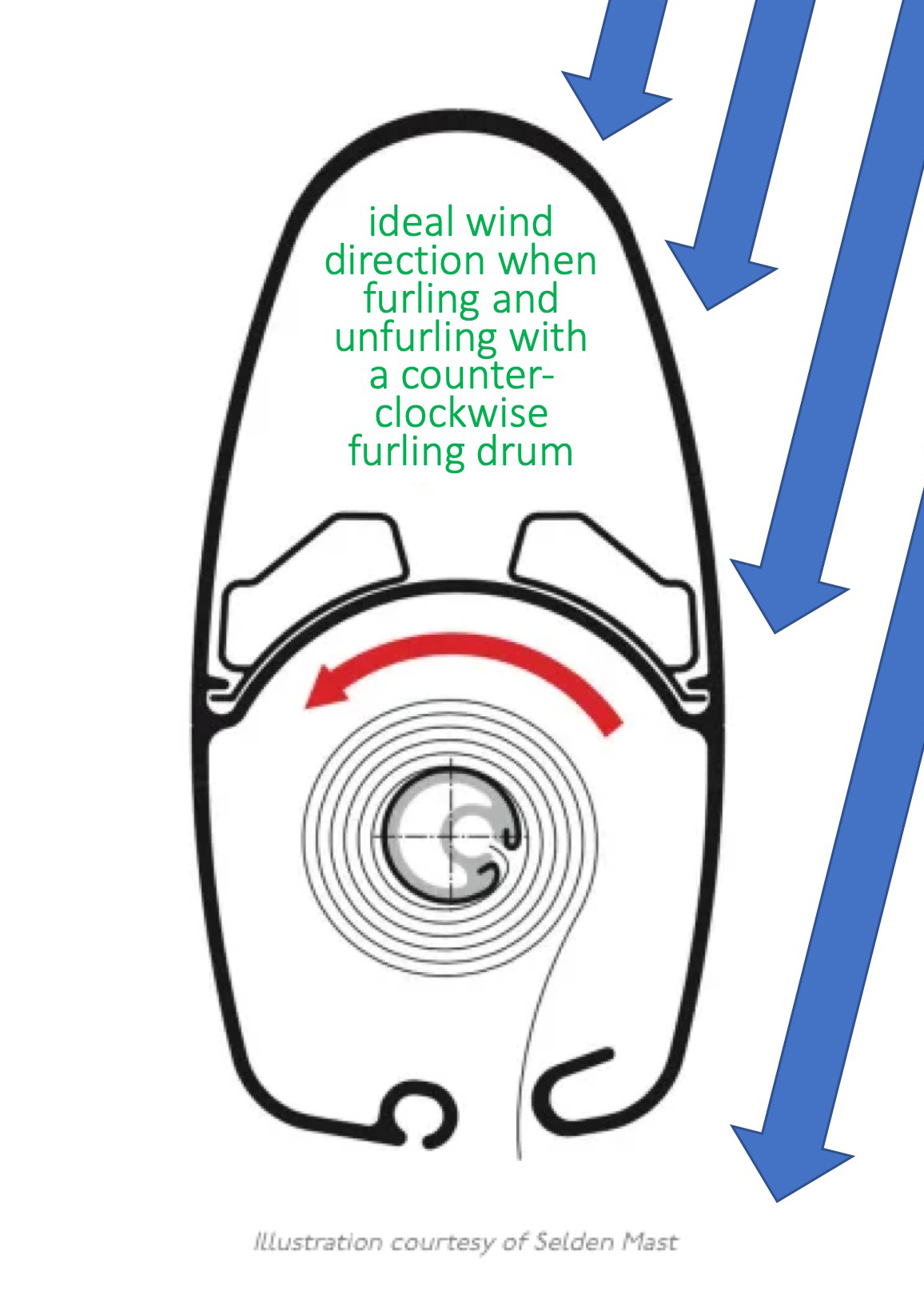
What is an in-mast furling mainsail?
Unlike a traditional mainsail that is hoisted and doused vertically with a halyard, an in-mast furling mainsail wraps around a tube inside a hollow mast. It is unfurled by an outhaul line and furled back in with a line labelled as the "inhaul."
Seven yachts in the Modern Sailing School & Club fleet have in-mast furling mainsails:
- Polaris (Beneteau Oceanis 30.1)
- Andiamo (Catalina 36)
- Grey Goose (Beneteau Oceanis 37)
- Survivor (Beneteau Oceanis 38)
- Liberty (Beneteau Oceanis 38.1)
- Firefly (Beneteau Oceanis 40.1)
- Attitude Adjustment (Beneteau Oceanis 41)
Furling Mainsail Advantages
- A furling mainsail is easy to reef and un-reef from the cockpit while underway - a great advantage in San Francisco Bay where winds can be highly variable.
- There's no need to flake and cover the mainsail when done sailing. Roll it up, close the line clutches, and you're done!
- Furling mains are easy to handle with short-handed crews.
Challenges
- An in-mast furling mainsail cannot have horizontal battens, which means less control over sail shape, especially as the sail ages.
- In-mast furling units consist of many moving parts, which require routine service and can fail. Modern Sailing performs preventative maintenance and inspects in-mast furling units every two weeks.
- If not handled properly while furling and unfurling, the sail may bunch up and jam inside the mast.
It's important to know how to properly handle an in-mast furling mainsail in order to prevent problems later on.
How To Unfurl The Mainsail
Your goal is for the crew to work together to unfurl the sail in a controlled manner. The trick is to maintain slight tension on the inhaul line as the sail comes out.
- If the dodger obscures the view of the sail, have a crew member stand where he or she can monitor the sail as it comes out.
- Steer the boat to head the bow into the wind. While keeping the boat "in irons" (otherwise known as the "no-sail zone)," fall off to the left, ideally, 2 - 3° to port. A small amount of starboard wind will help ease the sail out, but it's important to keep the boat in the "no sail zone" in order to maintain control of the sail.

- All MSC yachts have counter-clockwise furlers. For boats with clockwise furlers, turn slightly right, ideally, 2 - 3° to starboard when unfurling the mainsail. -
Open the mainsheet clutch and loosen the mainsheet. This will prevent the sail from accidentally powering up while being pulled out. (Note: always leave the mainsheet clutch open while the sail is unfurled or being furled.)
- Open the boom vang line clutch and loosen the line. This allows the boom to rise as the sail comes out.
- Wrap the outhaul line once or twice around a cabin top winch.
- Open the inhaul line clutch. Hold onto the inhaul line in one hand and ensure the rest of its tail is free to run.
- Pull the outhaul line while maintaining hand-tension on the inhaul line as the sail comes out. This is easier if one crew member pulls the outhaul while another keeps some tension on the inhaul. Without tension on the inhaul line, you run the risk of the mainsail unfurling too quickly, which can cause the sail to luff violently and tangle up the outhaul.
- Wrap the outhaul line around the winch and run it through the self-tailing jaw. Use a winch handle if needed to continue pulling the sail out until the clew reaches the reef point, or the limit mark at the end of the boom.
- Once the mainsail is fully unfurled (or unfurled to a desired reef point), close the outhaul and inhaul line clutches. Wrap the mainsheet on a cabin top winch and be sure to leave the mainsheet clutch open. Steer away from the wind to a close haul or reach and let the wind fill the sail.
- If necessary, you may adjust tension on the outhaul to trim and shape the sail.
How To Clear Furling Mainsail Jams
A common cause of a jam is loose wrapping during furling, which leads to binding inside the mast. Your goal is to rewind the sail tighter on the furler. Try the following steps:
- Close the inhaul line clutch.
- Wrap the inhaul line around the winch and run it through the self-tailing jaw.
- Wrap the outhaul line once or twice around on the other cabin top winch hold onto the tail firmly. Do not run it through the winch's self-tailing jaw.
- Open the outhaul line clutch.
- Grind the winch holding the inhaul line to bring the sail back in a foot or two. Maintain firm hand-tension on the outhaul line while furling.
- Close the outhaul clutch and run it back through the self-tailing jaw.
- Remove the inhaul line from the winch and open the inhaul clutch.
- Try again to unfurl the sail. As before, maintain hand-tension on the inhaul line as you pull on the outhaul. Grind the outhaul winch with caution - do not use excessive force.
- If the sail is still jammed, if conditions permit, send two crew members forward on deck. Repeat the above steps again, with one sailor tugging downward on the foot of the sail, and the other sailor tugging outward on the clew as the sail comes out.
Never force a stuck sail by grinding hard on a winch. Excessive force could damage the sail or other components. If you still cannot get the sail unfurled after a few attempts, head back to base and call the office. A technician will meet you at the dock to troubleshoot the problem.
Trimming a Furling Mainsail
- In high winds (>15 knots), flatten the sail to de-power it. Tighten the outhaul to increase horizontal tension. Tighten up the boom vang to increase vertical tension.
- If the foot of the sail is still too baggy after the clew has reached the end of the boom, you can tighten the foot of the sail a little more by tightening the inhaul. Keep the outhaul clutch closed and tighten the inhaul with caution - if you overtighten, you risk tearing the sail.
- In light winds, (<10 knots) a rounded shape in the sail will add more driving power. Loosen the outhaul and/or boom vang to give the sail a deeper curve or "belly."
- Main halyard tension is set by the MSC fleet technicians. Do not adjust the halyard. If the main halyard seems slack, report it when you fill out your electronic Boat Check-In Form.
Reefing the Mainsail
Reefing a furling mainsail is simple! Follow the steps below to furl the sail in part-way to shorten the sail. Some mainsails have marks on the foot of the sail to indicate suggested reef points, but you can customize your sail area to make it any size you like.
How To Furl Properly and Prevent Future Jams
Your goal is to wrap the sail tightly around the furler. Key: apply tension on the outhaul while furling in.
- Steer into the wind and fall off to the left, ideally 2 - 3° degrees to port.
- A slight starboard tack is acceptable if your mainsail wraps around the furler in a counter-clockwise direction. (A slight port tack will force the sail against the opening in the mast, making it difficult to furl the sail in.)
- A slight port tack is okay if a mainsail wraps around the furler in a clockwise direction. (A slight starboard tack will force the sail against the opening in the mast, making it difficult to furl the sail in.) - Tighten the boom vang line. This will lower the boom and flatten the sail, which helps it to wrap smoothly.
- Carefully unwrap the mainsheet from the winch and loosen the mainsheet.
- Wrap the outhaul once or twice on a cabin top winch. Keep a firm grip on the tail, but do not run it through the winch's self-tailing jaw.
- Wrap the inhaul line on the other cabin top winch and run it through the winch's self-tailing jaw.
- Open the outhaul clutch.
- Grind the winch holding the inhaul line to furl in the mainsail. Maintain some tension on the outhaul while furling to ensure the sail wraps tightly.
- Once the mainsail is fully furled, tighten up the mainsheet and close all clutches.
Want to learn more seamanship and safety tips? Check out the Member Resources section of our website. New articles are added frequently!
Article by Mary Elkins on January 17, 2020. Updated 2025 by Angel Moran.
Special thanks to Jim Haussener and Capt. Jeff Cathers for their contributions to this article.


